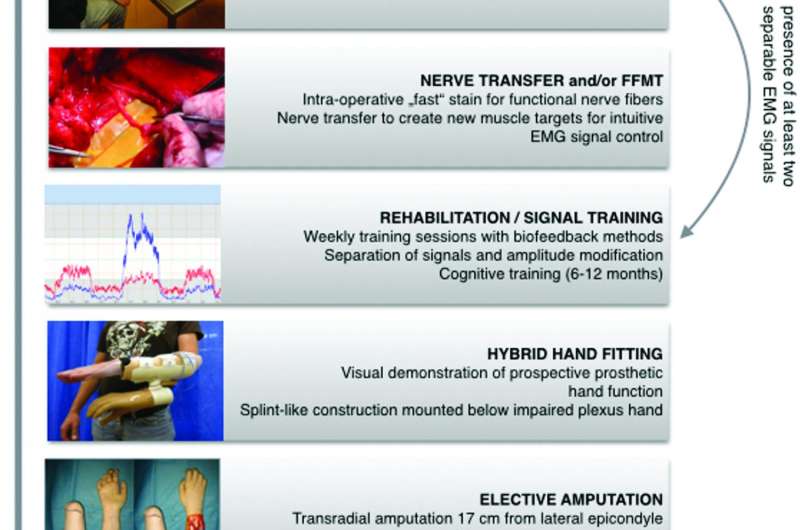Candidates for bionic hand reconstruction

Bionic hand? No longer only an image conjured by science fiction, bionic hands return functionality in cases of traumatic nerve and muscle loss. Certainly something to consider if you've lost your hand in an accident, but what if you still retain your hand, albeit a useless one? What would make a person voluntarily trade in a biological hand composed of flesh, blood, and bone for a prosthesis consisting of wires and synthetic material? And would the results be well worth the loss?
An answer to these questions can be found in a new Journal of Neurosurgery article, "Algorithm for bionic hand reconstruction in patients with global brachial plexopathies," by Laura A. Hruby, M.D., and colleagues from the Medical University of Vienna and the University of Applied Sciences FH Campus (Vienna). These researchers offer a treatment algorithm, or protocol, for identifying patients with global (flail arm) brachial plexus injuries who are likely to benefit from trading in their insensate and nonfunctional hand for a myoelectric prosthetic device.
Background
The brachial plexus is a network of sensory and motor fibers originating from spinal nerves in the lower cervical and upper thoracic spine that coalesce to form nerves that serve the shoulder, arm, and hand. A traumatic injury to the brachial plexus can cause these fibers to overstretch, sometimes avulsing (tearing) the spinal nerve roots from the spinal cord.
Traumatic brachial plexus injuries with nerve root avulsions occur most often in young adults. A variety of surgical procedures can be performed to restore nerve and muscle activity. Following these procedures, the shoulder and upper arm often regain stability and movement, and in some cases hand and finger movement can be restored—at least partially. In other cases, for a variety of reasons surgery fails and the hand remains a useless appendage.
Without use of the hand, the patient's life changes dramatically. Depending on occupation, the patient's economic livelihood may be jeopardized. Daily activities of living become difficult. Body image is transformed in a negative fashion, and chronic pain may become a new companion.
The Study
The authors recount their experience with patients who sought treatment for global brachial plexus injuries at the Center for Advanced Restoration of Extremity Function in Vienna between 2011 and 2015. In 16 patients, the nerve injury was so severe that no currently available biological intervention could restore adequate hand function. The authors offered these patients a bionic alternative: replacement of the useless biological hand with a myoelectric prosthetic device—a bionic hand.
The authors describe a treatment algorithm that they have developed for bionic hand reconstruction. It comprises several steps:
- Physical and psychological assessment of the patient. Patients must have useful shoulder and elbow function but no motor ability or sensation in the hand. In addition, patients must be able to face the challenges ahead.
- Identification of electromyographic signals in muscles of the forearm. Two separate signals are necessary to control a bionic hand. If fewer than two signals are present, surgical procedures may be performed.
- Optional: Surgery to perform selective nerve transfer and/or transplantation of healthy muscle to improve nerve conduction and muscle activation in the forearm when at least two electromyographic signals are not present.
- Brain Training: This biofeedback training allows the patient to target reinnervated muscles to control movement of the hand and forearm.
- Hybrid hand fitting. Patients are trained to use a prosthetic device with their own biosignals prior to hand amputation.
- Elective amputation of the useless biological hand.
- Replacement of the biological hand with a myoelectric prosthetic device, followed by additional training and testing of bionic hand function.
The authors report outcomes in the five patients in whom sufficient follow-up was obtained (at least 3 months after final prosthetic fitting). At the time the paper was written, the other 11 patients were still moving through earlier steps of the algorithm. Functional outcomes were assessed using the Action Research Arm Test (ARAT), the Southampton Hand Assessment Procedure (SHAP), and the Disabilities of the Arm, Shoulder, and Hand (DASH) questionnaire. Significant improvements in hand function were seen in all five patients and continued throughout the follow-up period.
Interestingly, deafferentation pain (a chronic pain syndrome often experienced by patients with global brachial plexus injuries), which had been severe in three of the five patients, lessened after patients became accustomed to working with the bionic hand. According to the authors, "patients reported a subjectively observed correlation between daily wearing time of the prosthesis and pain reduction. Thus when the prosthetic device could not be worn due to regular maintenance, pain was reported to increase again within days."
Imagine having increased hand-like function and less deafferentation pain. Would you trade in your useless biological hand for a bionic hand if one was offered? For some, the choice may be easier than you think.
When asked about the study, the senior investigator, Oskar C. Aszmann, M.D., Ph.D., stated, "For more than 25 years, I have dealt with patients suffering from devastating peripheral nerve lesions. Bionic reconstruction, as described in this paper, has been a real game changer since it offers hope and real help for patients who otherwise have none."
Accompanying this paper is an interesting editorial by Mustafa Nadi, M.D., and Rajiv Midha, M.D., M.Sc., F.R.C.S.C., describing global brachial plexus injuries as well as the current state of surgical procedures used to reconstruct hand function and their limited results. The authors discuss the present study and express interest in future reports on outcomes in other patients following the treatment algorithm at the Center for Advanced Restoration of Extremity Function.
More information: Hruby LA, Sturma A, Mayer JA, Pittermann A, Salminger S, Aszmann OC: Algorithm for bionic hand reconstruction in patients with global brachial plexopathies. Journal of Neurosurgery, published online, ahead of print, January 17, 2017; DOI: 10.3171/2016.6.JNS16154
Editorial: Nadi M, Midha R: Myoelectric functional hand prosthesis for total brachial plexus Injury. Journal of Neurosurgery, published online, ahead of print, January 17, 2017; DOI: 10.3171/2016.7.JNS161501













